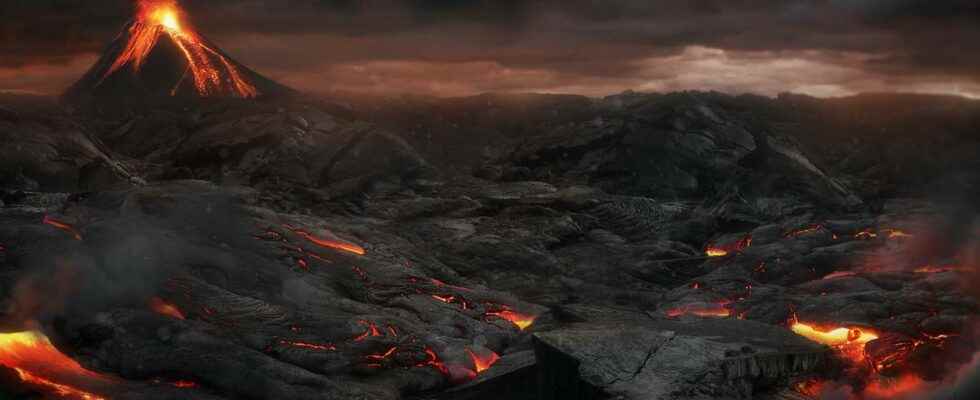You will also be interested
[EN VIDÉO] Interview: the three biggest volcanic eruptions in history Volcanologists are constantly confronted with volcanic eruptions. However, some are particularly brutal or intense. Futura-Sciences met Jacques-Marie Bardintzeff, doctor in volcanology, to find out what are the three largest known volcanic eruptions.
Among the volcanic manifestations experienced by the Earth throughout its history, the great outpourings basalt are certainly the most devastating. If the explosive eruptionslike those of Hunga-Tonga Ha’apai last Januaryare particularly spectacular and can cause significant damage, particularly because of the risk of tsunamithis type of rash usually only occurs on a duration relatively short, from a few hours to a few days. Conversely, large basaltic outpourings are characterized byepisode gigantic volumes of wash over periods of several hundred years. These cataclysmic eruptions occur in series, with the entire volcanic activity possibly spanning several hundred thousand years.
Large basaltic outpourings involved in most mass extinctions
These volcanic episodes produce thick basaltic plateaus referred to as Great Magmatic Provinces. The very fluid lava can indeed flow over considerable distances, covering tens of thousands of square kilometres. Successive flows will also accumulate until they reach a thickness of over 1,000 meters.
If these major volcanic events contributed significantly to continental crust growththey are also often associated with large mass extinctions that have marked the history of the Earth. The Deccan Traps would have contributed to the extinction of the dinosaurs. Similarly, the extinctions marking the end of the Permian, the end of the Trias and the Toarcian are each time associated with the formation of Great Magmatic Provinces (respectively the Traps of Siberia, the Central Atlantic Magmatic Province and the Karoo-Ferrar Magmatic Provinces). Because these eruptions are accompanied by a significant emission of gas and particles, who will come to modify the climate but also the chemistry oceans.
A brief volcanic winter followed by a long warming
Previous studies have shown that the large quantities of gas, dust and in particularsulfuric acid (H2N/A4) issued in theatmosphere during large eruptions could cause global cooling of the climate. The presence of these aerosols in the atmosphere disrupts the transmission of solar radiation down to the ground. This climatic phenomenon is known aswinter volcanic and was observed after the explosion of Lake Toba 74,000 years ago, or after the eruption of Phlegraean fields36,000 years ago.
However, a new study, published in the journal Geophysical Research Letters, shows that large basaltic outpourings tend to warm the climate. The person in charge would not be the CO2, but water vapour! The researchers of Goddard Space Flight Center to the Nasa thus observed the results on the climate of a simulated volcanic eruption lasting four years, based on the volumes of gas emitted during large basaltic outpourings.
It appears that a brief cooling actually occurs initially, but that this climatic episode is quickly replaced by a warming of the atmosphere. There are two mechanisms involved: large-scale destruction of the ozone layer and the warming of the upper atmosphere by water vapour.
A mechanism behind the disappearance of water on Mars?
Indeed, the aerosols formed from sulfuric acid reflect the light of suninitially inducing a cooling of the climate, but at the same time they absorb radiation infrared. This process will lead to a warming of the upper troposphere and bass stratosphere. This normally dry area will then become loaded with water vapour. However, water vapor is a greenhouse gas very effective, capable of emitting infrared radiation towards the ground. The surface of the Earth will thus gradually warm up. But the presence of water in the stratosphere will also lead to the destruction of the ozone layer. In their simulation, the researchers observe a drastic reduction in the ozone layer, of the order of two-thirds on a global scale. As if the entire planet had no more than a thickness of ozone comparable to the “hole” currently present at the level of theAntarctic.
These results could help explain why March today is so poor in water. The planet would indeed have experienced significant episodes of basaltic effusions, which would then have contributed to the evaporation of water in its atmosphere, favoring the escape into space of molecules ofhydrogen. Over very long periods of time, this process could well have led to the drying up of its oceans.
Support your independent scientific media: discover our subscription formulas!
4 good reasons to subscribe to Futura on Patreon:
- A site without any advertising from 3.29 euros per month.
- It is without commitment.
- Access to priority content, in preview, just for you.
- You support our business in the best possible way. A real motivation for us!
Interested in what you just read?
